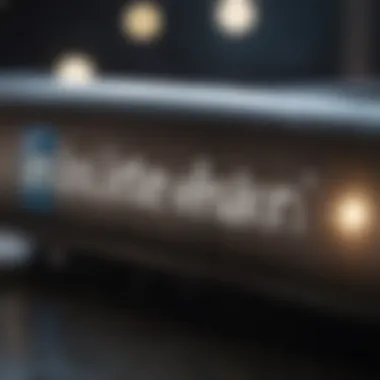Crafting a Professional Response to a LinkedIn Message: Mastering the Art of Effective Communication


Crafting a Professional Response to a Linked
In Message
Entrepreneurial Insights
When it comes to engaging with professional contacts on Linked In, the ability to formulate an adept response is crucial. Whether you are a seasoned entrepreneur, a burgeoning business owner, or a sales professional looking to expand your network, mastering the art of responding effectively to messages can significantly impact your success in the digital realm. This section will delve into the nuanced approach required to craft polished and impactful responses that resonate with your audience.
In the fast-paced world of online networking, the way you respond to messages can make or break a potential connection. Understanding the context of the communication, identifying the tone, and tailoring your response with precision are paramount. Each message represents an opportunity to showcase your professionalism, expertise, and courtesy. By honing your response skills, you can elevate your online persona and establish meaningful connections that may pave the way for valuable collaborations or opportunities.
Crafting a Polished Reply: Deciphering Context and Structuring Clarity
Before drafting a response to a message received on Linked In, take a moment to analyze the context in which the message was sent. Consider the sender's profile, their industry background, and the purpose of their communication. By discerning these details, you can tailor your response to align with the sender's expectations and objectives. Next, focus on structuring your reply with clarity and conciseness. Avoid verbose language and ambiguities, opting instead for a direct and professional tone. Clearly address any queries or requests made in the message and strive to provide value in your response.
Crafting a professional message entails not just conveying information but also establishing rapport and credibility. Ensure that your response is grammatically correct, devoid of errors, and reflects your attention to detail. In the digital landscape, where first impressions are formed swiftly, a well-crafted reply can set you apart as a knowledgeable and reliable professional. Embrace each message as an opportunity to showcase your communication skills and build a rapport that endures beyond the virtual realm.
Drawing on Industry Expertise: Leveraging Insights and Best Practices
Building a professional response involves drawing on industry expertise and best practices. By infusing your reply with relevant insights, industry trends, or personalized touches, you exhibit a depth of knowledge that commands respect. Share valuable resources, cite relevant experiences, or offer well-considered opinions to enrich your communication. This not only showcases your proficiency in the field but also fosters engaging dialogues that can lead to fruitful collaborations or exchanges.
Incorporating best practices such as timely responses, professional language, and a genuine interest in fostering connections can amplify the effectiveness of your messages. Display empathy, authenticity, and a proactive attitude in your replies to demonstrate your commitment to building meaningful relationships. By staying abreast of industry trends and integrating them into your communications, you position yourself as a forward-thinking professional who values continuous learning and growth.
Mastering the Art of Engagement: Elevating Your Networking Game
Mastering the art of crafting professional responses on Linked In is synonymous with elevating your networking game. By consistently delivering polished and effective replies, you establish yourself as a trusted resource within your professional ecosystem. Cultivate a reputation for reliability, expertise, and approachability through your responses, and watch as your network expands organically. Every interaction on LinkedIn presents an opportunity to bolster your personal brand, forge new connections, and unlock doors to unforeseen possibilities.
In summary, crafting a professional response to a Linked In message is an integral aspect of professional networking in the digital age. By investing time and effort into understanding the nuances of effective communication, structuring clear and impactful responses, and leveraging industry insights, you can position yourself as a dynamic and valued presence in the online sphere. Embrace each message as a chance to make a positive impression, foster meaningful connections, and propel your professional journey forward.
Stay tuned to discover more actionable insights and strategies for navigating the digital landscape with finesse and proficiency!
Introduction


In the realm of professional networking, the ability to craft a well-thought-out response to a Linked In message holds paramount significance. This article serves as a comprehensive guide, shedding light on the intricate process of formulating a polished and effective reply in the digital sphere. From deciphering the message's context to imbuing one's response with clarity and professionalism, this guide endeavors to equip individuals with the requisite skills to engage meaningfully within the realm of LinkedIn.
Understanding the Importance of Responding on Linked
In
Building Professional Connections
Delving into the essence of building professional connections through Linked In opens up a realm of opportunities for individuals seeking to expand their network. The key characteristic of fostering professional connections lies in establishing mutually beneficial relationships that transcend mere digital exchanges. The unique feature of building these connections lies in the potential it holds to broaden horizons, fostering collaborations, and unveiling new prospects. By engaging in this practice, individuals can harness the power of networking to forge alliances that propel their professional journey forward.
Showcasing Communication Skills
Showcasing one's communication prowess on Linked In serves as a testament to one's ability to articulate thoughts effectively in a professional setting. The crux of this aspect lies in conveying messages concisely, yet with impact, resonating with the intended audience. The hallmark of showcasing communication skills lies in the finesse with which individuals can navigate conversations, adeptly expressing thoughts and ideas. This unique feature sets individuals apart, positioning them as adept communicators capable of fostering engaging dialogues within the digital realm.
Setting the Right Tone
Professionalism vs. Casual Tone
Navigating the delicate balance between professionalism and a casual tone on Linked In showcases an individual's astuteness in adapting to diverse communication contexts. The key characteristic of this balancing act lies in choosing a tone that aligns with the intended message, resonating with the recipient while upholding professional decorum. The unique feature of striking this equilibrium lies in the ability to display versatility in communication styles, catering to different audiences with finesse. By understanding when to inject elements of professionalism or maintain a casual undertone, individuals can tailor their responses effectively, ensuring optimal engagement.
Aligning with your Personal Brand
Aligning one's responses with their personal brand amplifies the authenticity of their communication, fostering a sense of cohesion and credibility. The key characteristic of this alignment lies in maintaining consistency in messaging that reflects one's brand values and identity. The unique feature of this approach lies in its capacity to bolster brand perception, establishing a strong and recognizable online presence. By harmonizing responses with their personal brand, individuals can cultivate a distinct voice that resonates with their audience, solidifying their digital footprint with impact.
Analyzing the Message
When it comes to communicating effectively on platforms like Linked In, analyzing the received message is a crucial step. This section plays a pivotal role in guiding individuals towards crafting responses that are not only structured but also tailored to suit the context. By delving deep into the message's content, one can uncover valuable insights that inform the direction of the ensuing conversation. Analyzing the message serves as the foundation upon which a well-thought-out response is built.
Deciphering the Intent
Identifying the Purpose


Identifying the purpose behind a message is akin to deciphering the primary goal or objective that the sender aims to achieve through their communication. By discerning this underlying intent, one can respond in a manner that aligns with the sender's expectations. This step is crucial as it sets the tone for the entire interaction, ensuring that the response is not only relevant but also meaningful. Identifying the purpose allows for a customized response that resonates with the message sender, facilitating a more productive exchange of information within a professional setting.
Reading Between the Lines
Reading between the lines involves going beyond the explicit content of the message to grasp the implicit or underlying messages conveyed. This skill enables individuals to comprehend nuances, underlying sentiments, or unspoken queries that the sender may have embedded within their communication. By honing the ability to read between the lines, one can address hidden concerns, offer insights beyond the obvious, and demonstrate a keen understanding of the broader context. This proficiency enriches the response by acknowledging subtleties and nuances that might otherwise be overlooked, elevating the level of engagement and building rapport with the sender.
Researching the Sender
In the realm of professional networking, understanding the individual behind the message is as critical as comprehending the message itself. Researching the sender encompasses delving into their profile information to gain a comprehensive view of their background, interests, and professional endeavors. This proactive approach equips responders with valuable context that can inform the tone, content, and direction of their response, fostering a more personalized and targeted exchange.
Reviewing Profile Information
Reviewing profile information offers valuable insights into the sender's professional identity, expertise, and areas of interest. By exploring details such as work history, skills, endorsements, and mutual connections, one can tailor their response to resonate with the sender's professional profile. This personalized approach demonstrates attentiveness and a genuine interest in establishing a meaningful connection, setting the stage for a fruitful dialogue rooted in mutual understanding.
Understanding Mutual Connections
Understanding mutual connections sheds light on shared contacts or associations that bridge the gap between individuals on Linked In. Leveraging knowledge of mutual connections not only establishes a common ground for rapport-building but also opens doors to potential collaborations and synergies. By recognizing mutual connections, responders can leverage existing relationships to foster new connections, creating a web of professional interactions that transcend individual exchanges.
Crafting Your Response
Crafting a response on Linked In holds paramount importance within the realm of professional communication. When someone reaches out to you on LinkedIn, it presents a unique opportunity to showcase your professionalism and establish meaningful connections. A well-crafted response not only reflects your communication skills but also reinforces your personal brand. By responding thoughtfully and appropriately, you can further your networking goals and demonstrate your engagement within the platform. Crafting Your Response in this guide emphasizes the significance of projecting a professional image while fostering genuine connections to leverage opportunities effectively.
Structuring an Engaging Reply
Opening with a Professional Greeting
Commencing your response with a professional greeting sets the tone for the interaction. An initial greeting like 'Dear [Sender's Name]' or a courteous 'Hello' establishes a respectful and formal atmosphere, aligning with the professional standards expected on Linked In. This choice of opening cultivates a sense of courtesy and professionalism, indicating that you value the sender's message. The deliberate use of a professional greeting signals your attention to detail and exhibits etiquette, essential qualities in professional communication. While a professional greeting contributes to a poised and respectful tone, it also signifies your commitment to maintaining decorum and engaging thoughtfully on the platform.
Addressing Specific Points
Addressing the specific points raised in the message demonstrates your attentiveness and engagement with the sender's content. By acknowledging and responding to each point individually, you exhibit thoroughness and comprehension. This approach showcases your analytical skills and aptitude for detail-oriented communication. When you address specific points effectively, you convey a sense of respect for the sender's message, reinforcing your credibility and interest in the conversation. Tailoring your response to address each point demonstrates your focus on clarity and ensures that your reply is relevant and coherent.


Proposing Next Steps
Proposing next steps in your response signifies proactive engagement and paves the way for further communication. Whether suggesting a meeting, sharing additional resources, or offering collaboration opportunities, proposing next steps drives the conversation forward. By taking initiative and outlining possible actions, you demonstrate your commitment to progress and partnership. This aspect of crafting a response not only showcases your leadership abilities but also establishes a foundation for continued interaction. Proposing next steps fosters mutual understanding and indicates your intention to capitalize on the initial communication, setting the stage for future collaboration and networking opportunities.
Proofreading and Polishing
Checking for Errors
Thoroughly reviewing your response to check for errors is essential in maintaining professionalism and clarity. By meticulously examining your message for grammatical, spelling, or formatting mistakes, you uphold a standard of excellence in your communication. Ensuring accuracy and correctness in your response reflects your commitment to quality and attention to detail. By identifying and correcting errors, you bolster the credibility of your message and convey expertise in written communication. Vigilant checking for errors not only enhances the clarity of your response but also underscores your dedication to precision and professionalism.
Ensuring Clarity and Conciseness
Emphasizing clarity and conciseness in your response enhances its effectiveness and impact. Clear and concise communication ensures that your message is easily understood and avoids ambiguity or misinterpretation. By structuring your response with clarity, you facilitate seamless comprehension and reinforce the key points you aim to convey. Conciseness in communication demonstrates respect for the reader's time and attention, streamlining the exchange of information. Ensuring clarity and conciseness in your response signifies your commitment to effective communication and showcases your ability to convey ideas succinctly and precisely.
Enhancing Engagement
Enhancing engagement in the context of responding to a Linked In message is a critical aspect to consider. By encouraging interaction and fostering a deeper connection with the sender, you open up doors for potential collaboration and networking opportunities. Engaging thoughtfully demonstrates your interest and professionalism, setting the tone for a fruitful interaction. Moreover, by enhancing engagement, you create a more dynamic and meaningful exchange that can lead to valuable outcomes for your professional endeavors.
Encouraging Further Communication
Asking Thoughtful Questions
Asking thoughtful questions plays a pivotal role in amplifying engagement and nurturing relationships on Linked In. By posing insightful queries, you not only show your interest and curiosity but also elicit valuable information from the sender. Thoughtful questions demonstrate your attentiveness and desire to understand the other party's perspective, paving the way for meaningful conversations. Their strategic placement within your response can stimulate dialogue and create a platform for exchange that goes beyond mere formalities. Utilizing thoughtful questions adds depth and substance to your communication, enriching the interaction and strengthening professional ties.
Expressing Interest in Collaboration
Expressing interest in collaboration is a strategic approach to fostering engagement and building rapport on Linked In. By showing openness to potential joint efforts, you convey your willingness to explore mutually beneficial opportunities. This proactive stance demonstrates your proactive approach and can lead to the discovery of synergies that may enhance your professional pursuits. Expressing interest in collaboration sets a positive tone for future interactions, laying the groundwork for productive partnerships. By articulating your eagerness to collaborate, you signal your readiness to expand your network and explore innovative possibilities, elevating your profile within the professional sphere.
Closing on a Positive Note
Expressing Appreciation
Expressing appreciation at the conclusion of your response is a gesture that signifies respect and gratitude towards the sender. By acknowledging their message and expressing thanks for their communication, you exhibit courtesy and professionalism. Appreciation fosters goodwill and leaves a positive impression, enhancing the overall tone of the interaction. It creates a sense of reciprocity and acknowledges the effort and time invested by the other party, nurturing a cordial relationship.
Offering Assistance
Offering assistance as a concluding gesture showcases your willingness to support and collaborate further. By extending a helping hand or providing resources, you demonstrate your commitment to fostering synergistic connections. Offering assistance reinforces your sincerity and builds credibility, positioning you as a valuable contact within your professional network. It opens avenues for future engagements and solidifies your reputation as a proactive and resourceful individual, enriching your professional relationships.







